Comparative Analysis: Zara, H&M, Benetton Supply Chain Management
VerifiedAdded on 2020/04/13
|8
|1862
|57
Report
AI Summary
This report offers a comprehensive comparative analysis of the supply chain and retail management strategies employed by Zara, H&M, and Benetton, three prominent players in the fast fashion industry. It examines the design, manufacturing, and distribution stages of their supply chains, highlighting the unique approaches each company takes to gain a competitive edge. The report delves into the design processes, from market specialists to customer feedback, and contrasts the manufacturing practices, including sourcing and production methods. Furthermore, it explores the distribution channels, including warehousing, logistics, and retail stage operations, emphasizing the role of technology and efficiency. The report also provides an overall view of how the companies compete and concludes by highlighting the importance of effective information systems and automated warehousing in achieving market goals and increasing profitability.
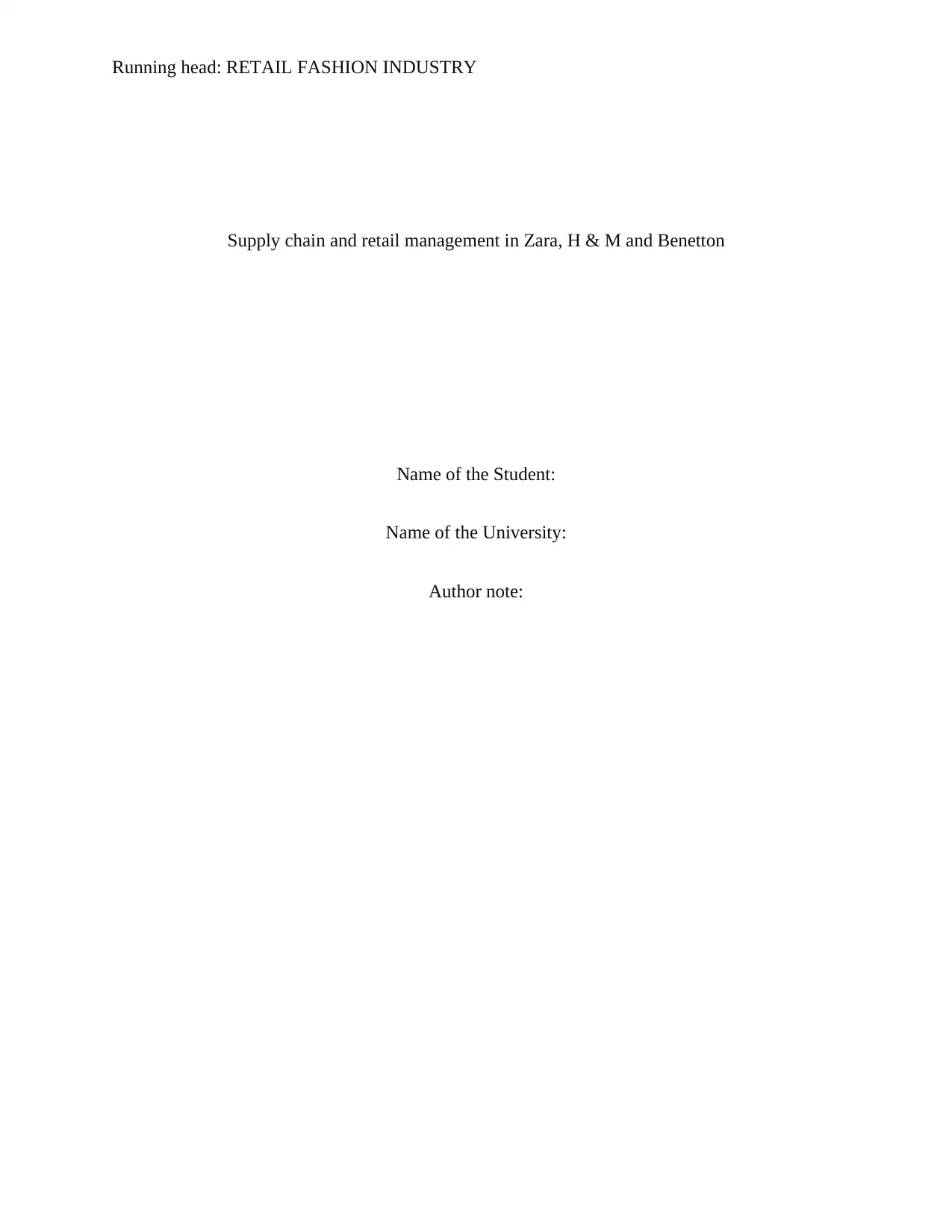
Running head: RETAIL FASHION INDUSTRY
Supply chain and retail management in Zara, H & M and Benetton
Name of the Student:
Name of the University:
Author note:
Supply chain and retail management in Zara, H & M and Benetton
Name of the Student:
Name of the University:
Author note:
Paraphrase This Document
Need a fresh take? Get an instant paraphrase of this document with our AI Paraphraser
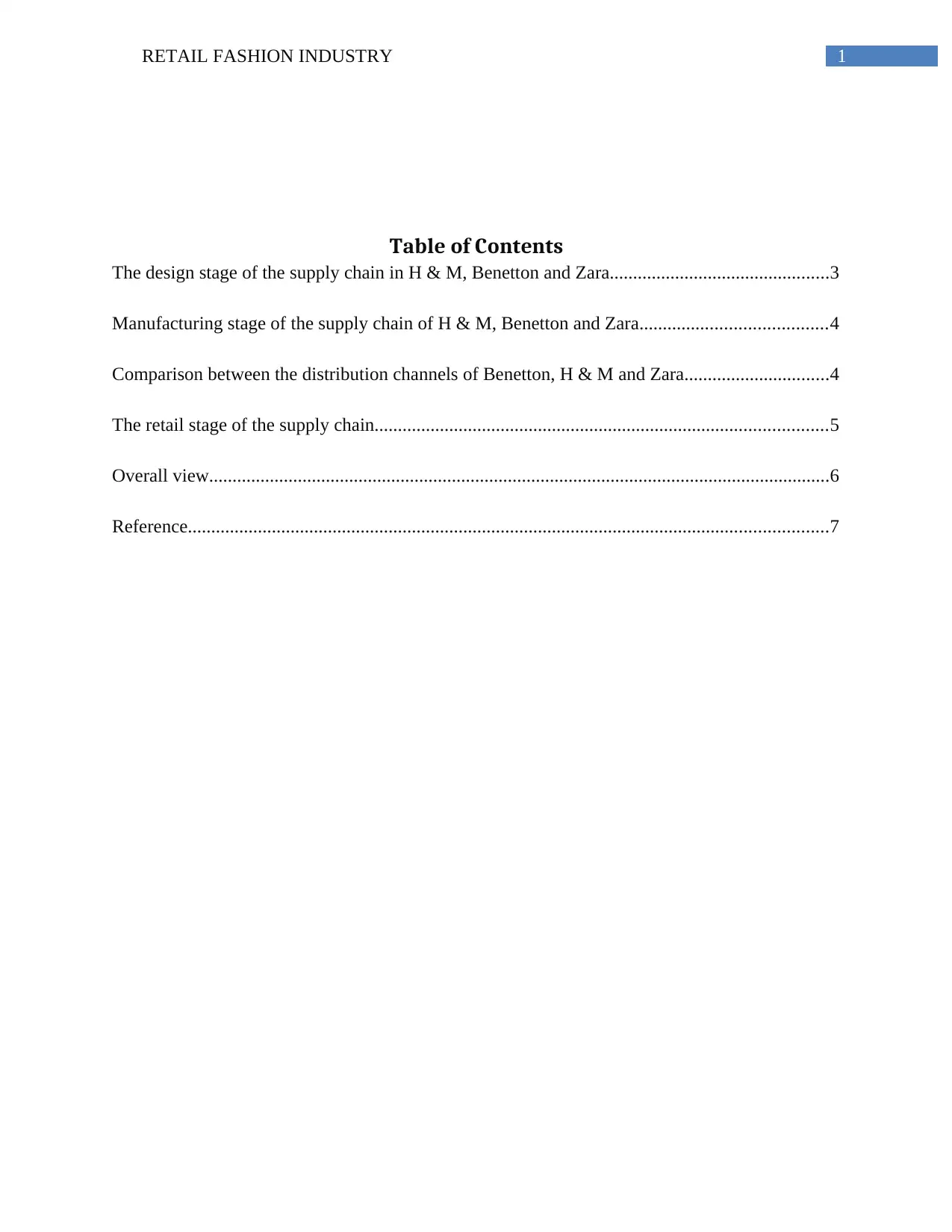
1RETAIL FASHION INDUSTRY
Table of Contents
The design stage of the supply chain in H & M, Benetton and Zara...............................................3
Manufacturing stage of the supply chain of H & M, Benetton and Zara........................................4
Comparison between the distribution channels of Benetton, H & M and Zara...............................4
The retail stage of the supply chain.................................................................................................5
Overall view.....................................................................................................................................6
Reference.........................................................................................................................................7
Table of Contents
The design stage of the supply chain in H & M, Benetton and Zara...............................................3
Manufacturing stage of the supply chain of H & M, Benetton and Zara........................................4
Comparison between the distribution channels of Benetton, H & M and Zara...............................4
The retail stage of the supply chain.................................................................................................5
Overall view.....................................................................................................................................6
Reference.........................................................................................................................................7
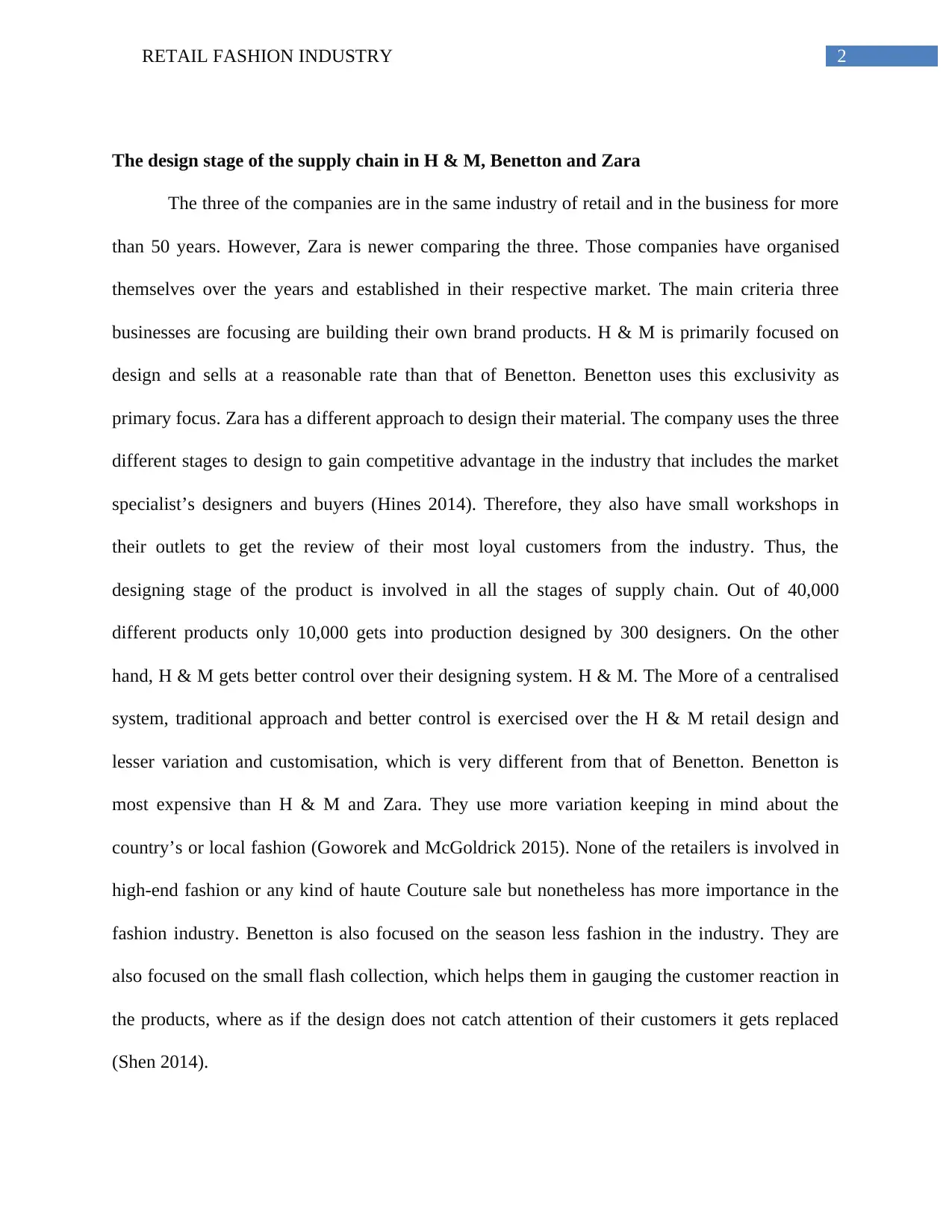
2RETAIL FASHION INDUSTRY
The design stage of the supply chain in H & M, Benetton and Zara
The three of the companies are in the same industry of retail and in the business for more
than 50 years. However, Zara is newer comparing the three. Those companies have organised
themselves over the years and established in their respective market. The main criteria three
businesses are focusing are building their own brand products. H & M is primarily focused on
design and sells at a reasonable rate than that of Benetton. Benetton uses this exclusivity as
primary focus. Zara has a different approach to design their material. The company uses the three
different stages to design to gain competitive advantage in the industry that includes the market
specialist’s designers and buyers (Hines 2014). Therefore, they also have small workshops in
their outlets to get the review of their most loyal customers from the industry. Thus, the
designing stage of the product is involved in all the stages of supply chain. Out of 40,000
different products only 10,000 gets into production designed by 300 designers. On the other
hand, H & M gets better control over their designing system. H & M. The More of a centralised
system, traditional approach and better control is exercised over the H & M retail design and
lesser variation and customisation, which is very different from that of Benetton. Benetton is
most expensive than H & M and Zara. They use more variation keeping in mind about the
country’s or local fashion (Goworek and McGoldrick 2015). None of the retailers is involved in
high-end fashion or any kind of haute Couture sale but nonetheless has more importance in the
fashion industry. Benetton is also focused on the season less fashion in the industry. They are
also focused on the small flash collection, which helps them in gauging the customer reaction in
the products, where as if the design does not catch attention of their customers it gets replaced
(Shen 2014).
The design stage of the supply chain in H & M, Benetton and Zara
The three of the companies are in the same industry of retail and in the business for more
than 50 years. However, Zara is newer comparing the three. Those companies have organised
themselves over the years and established in their respective market. The main criteria three
businesses are focusing are building their own brand products. H & M is primarily focused on
design and sells at a reasonable rate than that of Benetton. Benetton uses this exclusivity as
primary focus. Zara has a different approach to design their material. The company uses the three
different stages to design to gain competitive advantage in the industry that includes the market
specialist’s designers and buyers (Hines 2014). Therefore, they also have small workshops in
their outlets to get the review of their most loyal customers from the industry. Thus, the
designing stage of the product is involved in all the stages of supply chain. Out of 40,000
different products only 10,000 gets into production designed by 300 designers. On the other
hand, H & M gets better control over their designing system. H & M. The More of a centralised
system, traditional approach and better control is exercised over the H & M retail design and
lesser variation and customisation, which is very different from that of Benetton. Benetton is
most expensive than H & M and Zara. They use more variation keeping in mind about the
country’s or local fashion (Goworek and McGoldrick 2015). None of the retailers is involved in
high-end fashion or any kind of haute Couture sale but nonetheless has more importance in the
fashion industry. Benetton is also focused on the season less fashion in the industry. They are
also focused on the small flash collection, which helps them in gauging the customer reaction in
the products, where as if the design does not catch attention of their customers it gets replaced
(Shen 2014).
⊘ This is a preview!⊘
Do you want full access?
Subscribe today to unlock all pages.

Trusted by 1+ million students worldwide
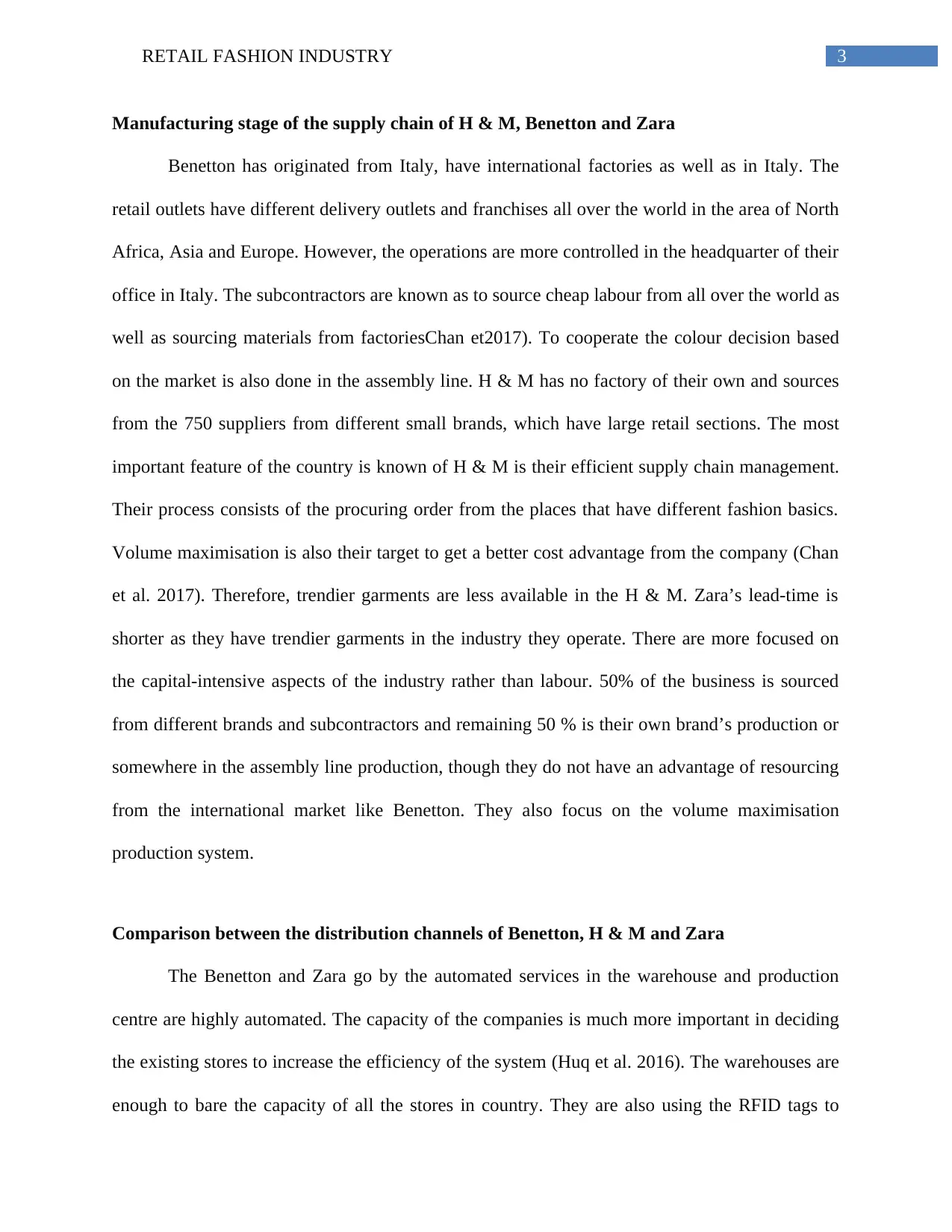
3RETAIL FASHION INDUSTRY
Manufacturing stage of the supply chain of H & M, Benetton and Zara
Benetton has originated from Italy, have international factories as well as in Italy. The
retail outlets have different delivery outlets and franchises all over the world in the area of North
Africa, Asia and Europe. However, the operations are more controlled in the headquarter of their
office in Italy. The subcontractors are known as to source cheap labour from all over the world as
well as sourcing materials from factoriesChan et2017). To cooperate the colour decision based
on the market is also done in the assembly line. H & M has no factory of their own and sources
from the 750 suppliers from different small brands, which have large retail sections. The most
important feature of the country is known of H & M is their efficient supply chain management.
Their process consists of the procuring order from the places that have different fashion basics.
Volume maximisation is also their target to get a better cost advantage from the company (Chan
et al. 2017). Therefore, trendier garments are less available in the H & M. Zara’s lead-time is
shorter as they have trendier garments in the industry they operate. There are more focused on
the capital-intensive aspects of the industry rather than labour. 50% of the business is sourced
from different brands and subcontractors and remaining 50 % is their own brand’s production or
somewhere in the assembly line production, though they do not have an advantage of resourcing
from the international market like Benetton. They also focus on the volume maximisation
production system.
Comparison between the distribution channels of Benetton, H & M and Zara
The Benetton and Zara go by the automated services in the warehouse and production
centre are highly automated. The capacity of the companies is much more important in deciding
the existing stores to increase the efficiency of the system (Huq et al. 2016). The warehouses are
enough to bare the capacity of all the stores in country. They are also using the RFID tags to
Manufacturing stage of the supply chain of H & M, Benetton and Zara
Benetton has originated from Italy, have international factories as well as in Italy. The
retail outlets have different delivery outlets and franchises all over the world in the area of North
Africa, Asia and Europe. However, the operations are more controlled in the headquarter of their
office in Italy. The subcontractors are known as to source cheap labour from all over the world as
well as sourcing materials from factoriesChan et2017). To cooperate the colour decision based
on the market is also done in the assembly line. H & M has no factory of their own and sources
from the 750 suppliers from different small brands, which have large retail sections. The most
important feature of the country is known of H & M is their efficient supply chain management.
Their process consists of the procuring order from the places that have different fashion basics.
Volume maximisation is also their target to get a better cost advantage from the company (Chan
et al. 2017). Therefore, trendier garments are less available in the H & M. Zara’s lead-time is
shorter as they have trendier garments in the industry they operate. There are more focused on
the capital-intensive aspects of the industry rather than labour. 50% of the business is sourced
from different brands and subcontractors and remaining 50 % is their own brand’s production or
somewhere in the assembly line production, though they do not have an advantage of resourcing
from the international market like Benetton. They also focus on the volume maximisation
production system.
Comparison between the distribution channels of Benetton, H & M and Zara
The Benetton and Zara go by the automated services in the warehouse and production
centre are highly automated. The capacity of the companies is much more important in deciding
the existing stores to increase the efficiency of the system (Huq et al. 2016). The warehouses are
enough to bare the capacity of all the stores in country. They are also using the RFID tags to
Paraphrase This Document
Need a fresh take? Get an instant paraphrase of this document with our AI Paraphraser
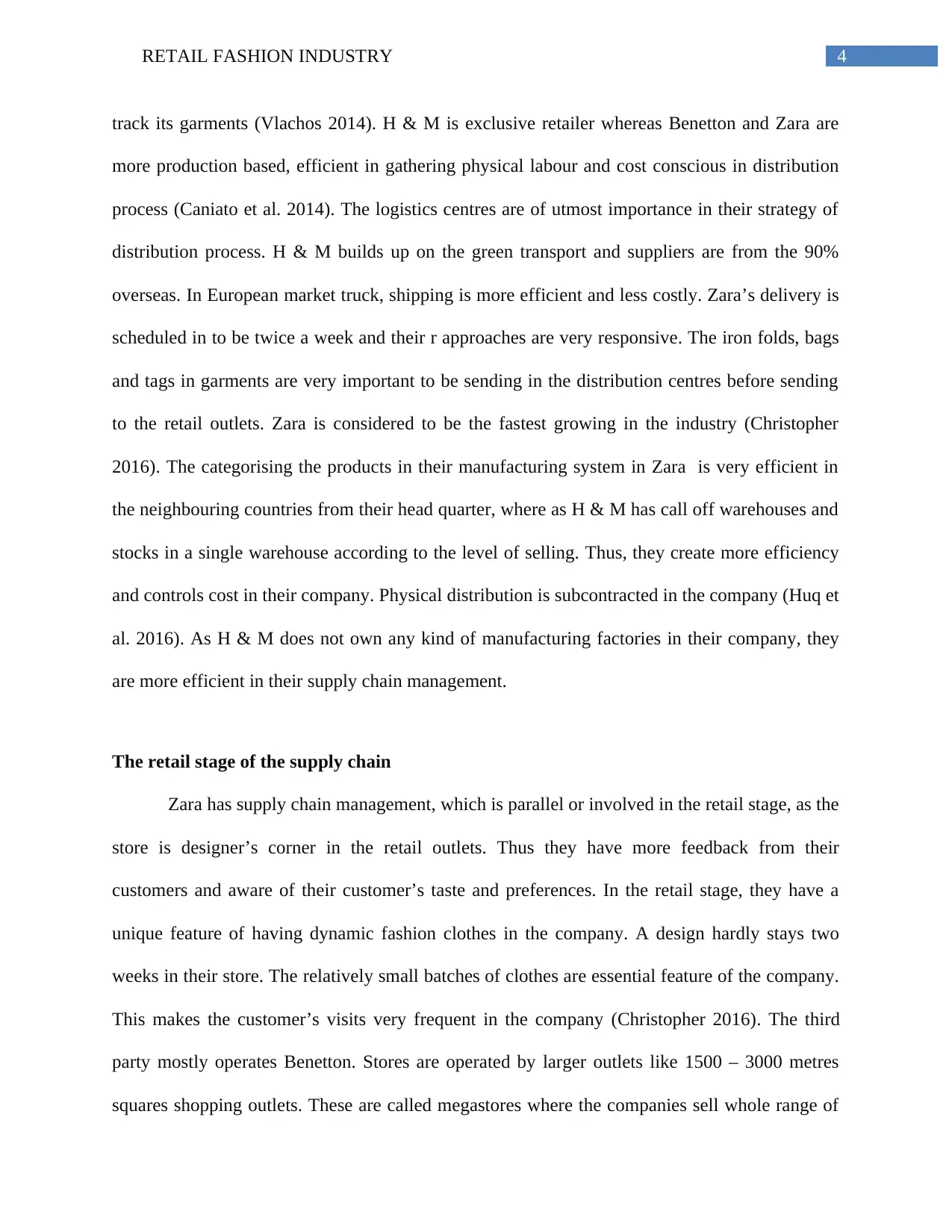
4RETAIL FASHION INDUSTRY
track its garments (Vlachos 2014). H & M is exclusive retailer whereas Benetton and Zara are
more production based, efficient in gathering physical labour and cost conscious in distribution
process (Caniato et al. 2014). The logistics centres are of utmost importance in their strategy of
distribution process. H & M builds up on the green transport and suppliers are from the 90%
overseas. In European market truck, shipping is more efficient and less costly. Zara’s delivery is
scheduled in to be twice a week and their r approaches are very responsive. The iron folds, bags
and tags in garments are very important to be sending in the distribution centres before sending
to the retail outlets. Zara is considered to be the fastest growing in the industry (Christopher
2016). The categorising the products in their manufacturing system in Zara is very efficient in
the neighbouring countries from their head quarter, where as H & M has call off warehouses and
stocks in a single warehouse according to the level of selling. Thus, they create more efficiency
and controls cost in their company. Physical distribution is subcontracted in the company (Huq et
al. 2016). As H & M does not own any kind of manufacturing factories in their company, they
are more efficient in their supply chain management.
The retail stage of the supply chain
Zara has supply chain management, which is parallel or involved in the retail stage, as the
store is designer’s corner in the retail outlets. Thus they have more feedback from their
customers and aware of their customer’s taste and preferences. In the retail stage, they have a
unique feature of having dynamic fashion clothes in the company. A design hardly stays two
weeks in their store. The relatively small batches of clothes are essential feature of the company.
This makes the customer’s visits very frequent in the company (Christopher 2016). The third
party mostly operates Benetton. Stores are operated by larger outlets like 1500 – 3000 metres
squares shopping outlets. These are called megastores where the companies sell whole range of
track its garments (Vlachos 2014). H & M is exclusive retailer whereas Benetton and Zara are
more production based, efficient in gathering physical labour and cost conscious in distribution
process (Caniato et al. 2014). The logistics centres are of utmost importance in their strategy of
distribution process. H & M builds up on the green transport and suppliers are from the 90%
overseas. In European market truck, shipping is more efficient and less costly. Zara’s delivery is
scheduled in to be twice a week and their r approaches are very responsive. The iron folds, bags
and tags in garments are very important to be sending in the distribution centres before sending
to the retail outlets. Zara is considered to be the fastest growing in the industry (Christopher
2016). The categorising the products in their manufacturing system in Zara is very efficient in
the neighbouring countries from their head quarter, where as H & M has call off warehouses and
stocks in a single warehouse according to the level of selling. Thus, they create more efficiency
and controls cost in their company. Physical distribution is subcontracted in the company (Huq et
al. 2016). As H & M does not own any kind of manufacturing factories in their company, they
are more efficient in their supply chain management.
The retail stage of the supply chain
Zara has supply chain management, which is parallel or involved in the retail stage, as the
store is designer’s corner in the retail outlets. Thus they have more feedback from their
customers and aware of their customer’s taste and preferences. In the retail stage, they have a
unique feature of having dynamic fashion clothes in the company. A design hardly stays two
weeks in their store. The relatively small batches of clothes are essential feature of the company.
This makes the customer’s visits very frequent in the company (Christopher 2016). The third
party mostly operates Benetton. Stores are operated by larger outlets like 1500 – 3000 metres
squares shopping outlets. These are called megastores where the companies sell whole range of
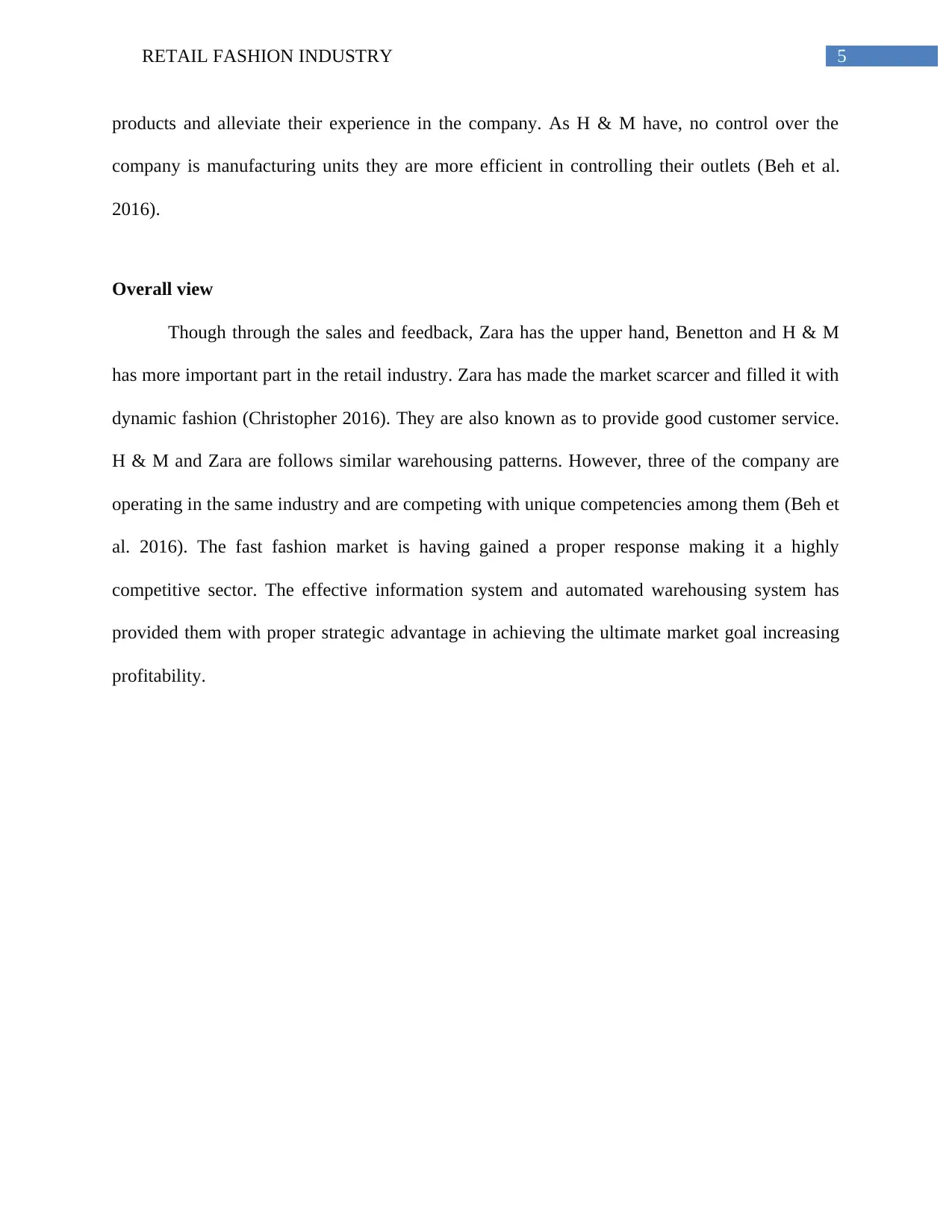
5RETAIL FASHION INDUSTRY
products and alleviate their experience in the company. As H & M have, no control over the
company is manufacturing units they are more efficient in controlling their outlets (Beh et al.
2016).
Overall view
Though through the sales and feedback, Zara has the upper hand, Benetton and H & M
has more important part in the retail industry. Zara has made the market scarcer and filled it with
dynamic fashion (Christopher 2016). They are also known as to provide good customer service.
H & M and Zara are follows similar warehousing patterns. However, three of the company are
operating in the same industry and are competing with unique competencies among them (Beh et
al. 2016). The fast fashion market is having gained a proper response making it a highly
competitive sector. The effective information system and automated warehousing system has
provided them with proper strategic advantage in achieving the ultimate market goal increasing
profitability.
products and alleviate their experience in the company. As H & M have, no control over the
company is manufacturing units they are more efficient in controlling their outlets (Beh et al.
2016).
Overall view
Though through the sales and feedback, Zara has the upper hand, Benetton and H & M
has more important part in the retail industry. Zara has made the market scarcer and filled it with
dynamic fashion (Christopher 2016). They are also known as to provide good customer service.
H & M and Zara are follows similar warehousing patterns. However, three of the company are
operating in the same industry and are competing with unique competencies among them (Beh et
al. 2016). The fast fashion market is having gained a proper response making it a highly
competitive sector. The effective information system and automated warehousing system has
provided them with proper strategic advantage in achieving the ultimate market goal increasing
profitability.
⊘ This is a preview!⊘
Do you want full access?
Subscribe today to unlock all pages.

Trusted by 1+ million students worldwide
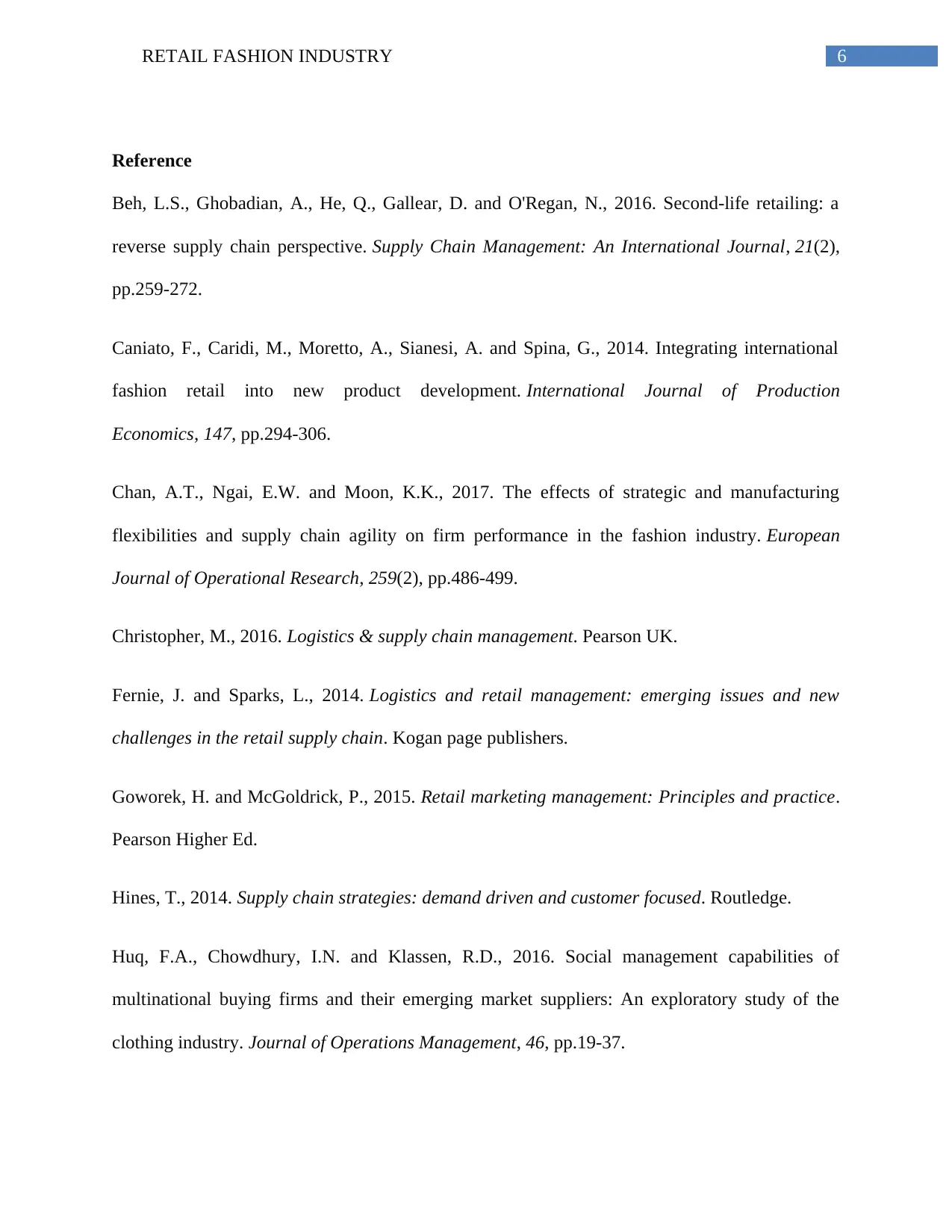
6RETAIL FASHION INDUSTRY
Reference
Beh, L.S., Ghobadian, A., He, Q., Gallear, D. and O'Regan, N., 2016. Second-life retailing: a
reverse supply chain perspective. Supply Chain Management: An International Journal, 21(2),
pp.259-272.
Caniato, F., Caridi, M., Moretto, A., Sianesi, A. and Spina, G., 2014. Integrating international
fashion retail into new product development. International Journal of Production
Economics, 147, pp.294-306.
Chan, A.T., Ngai, E.W. and Moon, K.K., 2017. The effects of strategic and manufacturing
flexibilities and supply chain agility on firm performance in the fashion industry. European
Journal of Operational Research, 259(2), pp.486-499.
Christopher, M., 2016. Logistics & supply chain management. Pearson UK.
Fernie, J. and Sparks, L., 2014. Logistics and retail management: emerging issues and new
challenges in the retail supply chain. Kogan page publishers.
Goworek, H. and McGoldrick, P., 2015. Retail marketing management: Principles and practice.
Pearson Higher Ed.
Hines, T., 2014. Supply chain strategies: demand driven and customer focused. Routledge.
Huq, F.A., Chowdhury, I.N. and Klassen, R.D., 2016. Social management capabilities of
multinational buying firms and their emerging market suppliers: An exploratory study of the
clothing industry. Journal of Operations Management, 46, pp.19-37.
Reference
Beh, L.S., Ghobadian, A., He, Q., Gallear, D. and O'Regan, N., 2016. Second-life retailing: a
reverse supply chain perspective. Supply Chain Management: An International Journal, 21(2),
pp.259-272.
Caniato, F., Caridi, M., Moretto, A., Sianesi, A. and Spina, G., 2014. Integrating international
fashion retail into new product development. International Journal of Production
Economics, 147, pp.294-306.
Chan, A.T., Ngai, E.W. and Moon, K.K., 2017. The effects of strategic and manufacturing
flexibilities and supply chain agility on firm performance in the fashion industry. European
Journal of Operational Research, 259(2), pp.486-499.
Christopher, M., 2016. Logistics & supply chain management. Pearson UK.
Fernie, J. and Sparks, L., 2014. Logistics and retail management: emerging issues and new
challenges in the retail supply chain. Kogan page publishers.
Goworek, H. and McGoldrick, P., 2015. Retail marketing management: Principles and practice.
Pearson Higher Ed.
Hines, T., 2014. Supply chain strategies: demand driven and customer focused. Routledge.
Huq, F.A., Chowdhury, I.N. and Klassen, R.D., 2016. Social management capabilities of
multinational buying firms and their emerging market suppliers: An exploratory study of the
clothing industry. Journal of Operations Management, 46, pp.19-37.
Paraphrase This Document
Need a fresh take? Get an instant paraphrase of this document with our AI Paraphraser
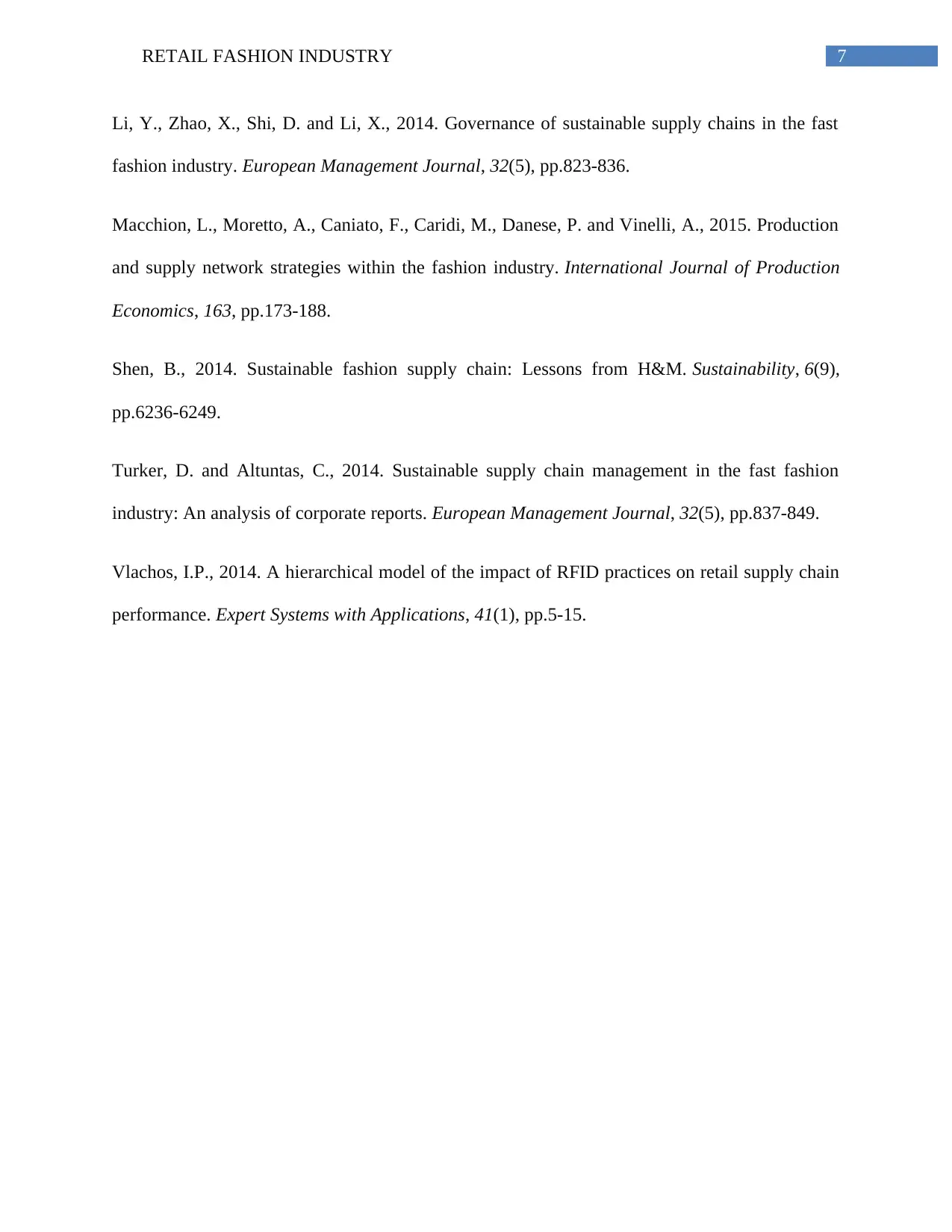
7RETAIL FASHION INDUSTRY
Li, Y., Zhao, X., Shi, D. and Li, X., 2014. Governance of sustainable supply chains in the fast
fashion industry. European Management Journal, 32(5), pp.823-836.
Macchion, L., Moretto, A., Caniato, F., Caridi, M., Danese, P. and Vinelli, A., 2015. Production
and supply network strategies within the fashion industry. International Journal of Production
Economics, 163, pp.173-188.
Shen, B., 2014. Sustainable fashion supply chain: Lessons from H&M. Sustainability, 6(9),
pp.6236-6249.
Turker, D. and Altuntas, C., 2014. Sustainable supply chain management in the fast fashion
industry: An analysis of corporate reports. European Management Journal, 32(5), pp.837-849.
Vlachos, I.P., 2014. A hierarchical model of the impact of RFID practices on retail supply chain
performance. Expert Systems with Applications, 41(1), pp.5-15.
Li, Y., Zhao, X., Shi, D. and Li, X., 2014. Governance of sustainable supply chains in the fast
fashion industry. European Management Journal, 32(5), pp.823-836.
Macchion, L., Moretto, A., Caniato, F., Caridi, M., Danese, P. and Vinelli, A., 2015. Production
and supply network strategies within the fashion industry. International Journal of Production
Economics, 163, pp.173-188.
Shen, B., 2014. Sustainable fashion supply chain: Lessons from H&M. Sustainability, 6(9),
pp.6236-6249.
Turker, D. and Altuntas, C., 2014. Sustainable supply chain management in the fast fashion
industry: An analysis of corporate reports. European Management Journal, 32(5), pp.837-849.
Vlachos, I.P., 2014. A hierarchical model of the impact of RFID practices on retail supply chain
performance. Expert Systems with Applications, 41(1), pp.5-15.
1 out of 8
Related Documents
Your All-in-One AI-Powered Toolkit for Academic Success.
+13062052269
info@desklib.com
Available 24*7 on WhatsApp / Email
![[object Object]](/_next/static/media/star-bottom.7253800d.svg)
Unlock your academic potential
Copyright © 2020–2025 A2Z Services. All Rights Reserved. Developed and managed by ZUCOL.





